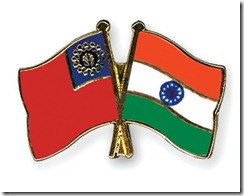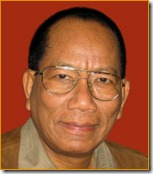By Brigadier S K Chatterji (retd)
 The best course of action for India remains to work within the space it has created in Myanmar and not make the junta too apprehensive, while still trying to nudge for greater political reforms, writes Brigadier S K Chatterji (retd)
The best course of action for India remains to work within the space it has created in Myanmar and not make the junta too apprehensive, while still trying to nudge for greater political reforms, writes Brigadier S K Chatterji (retd)
Come October, the Myanmarese people have a date with a supposedly profound event in their lives. The ruling military junta has promised to hold elections for a parliament where it has already reserved 25 percent of the seats for itself. Notwithstanding such a glaring departure from democratic norms, this is the first election (promised) after 1990, when the incarcerated Aung San Suu Kyi's party National League for Democracy won a majority that the ruling junta then, did not honor.
Myanmar is strategically situated to generate ample interest in the two Asian giants that share its borders, India and China. It provides the land bridge between south, southeast Asia and China. Its southern shores, jutting into the Andaman Sea, provide the western province of Yunnan, China a much required outlet to the seas. China also gains direct access to Bay of Bengal, bypassing the narrow Strait of Malacca.
For India, Myanmar provides an outlet to the sea for the seven land-locked northeastern states. Trade and commerce with Myanmar provides a market to this region, just as it holds out a similar option for Yunnan. Besides, some of our northeast insurgency movements have found safe sanctuaries in Myanmar, in the past.
The Myanmarese military junta initiated the march to democracy with a referendum to have its draft constitution approved in 2008. The referendum had coincided with Cyclone Nargis that left a trail of devastation and loss of life in its wake. However, the military junta carried on with the referendum in spite of calls for postponement by a lot of countries. The results of the referendum were as surprising as the elusive logic for its conduct under the circumstances; 92 percent voters, presumably, voted for the new constitution.
Obviously, the exercise in fudging was undertaken without any concern for international opinion or domestic concerns.
Indian response to events in Myanmar over the decades, have graduated from idealistic to hardnosed pragmatic. While we were fairly strident in our condemnation when General Ne Win usurped power in a military coup in 1968, have called for the release of opposition leader and NLD chairperson Aung San Suu Kyi's release, periodically, conferred the Jawaharlal Nehru Award for International Understanding on her in 1995, the current approach is more a hands off attitude best expressed by our foreign minister during his visit in 2007, "... we would like democracy to flourish everywhere. But this is for every country to decide for itself."
The pragmatism apparent in the Indian policy has been spurred by the fact of our losing ground in Yangon to China over the years. The relationship between the Chinese and Myanmarese has improved steadily since 1988, after General Ne Win's days. They have invested heavily enough in Myanmar to have replaced Thailand as that country's major trading partner. The pipeline project currently being pursued will provide gas to China's western provinces by 2015; not only making cheaper energy available, but also providing the Myanmar junta much needed cash flows, having been denied any World Bank aid since 1990, post sanctions imposed on it by certain western countries.
The new roads, rails, bridges have also led to massive influx of Chinese into Myanmar. Of strategic significance are roads along the Irrawaddy river that lead south to the coast. Also, of strategic dimensions is the increase of Chinese settlers in Myanmar.
Chinese involvement in Myanmar's military buildup and ports is also of concern. The famous String of Pearls that China is creating to limit India's sea power in the Indian Ocean, includes the Sittwe Port in Myanmar. This string's pearls include China's southernmost province Hainan Islands; Sittwe, Coco Islands and certain other port facilities in Myanmar; Chittagong in Bangladesh, Hambantota in Sri Lanka, Gwadhar in Pakistan, and Nepal.
The ban imposed by western nations and a rather idealistic stance of our foreign policy, were the primers that the Chinese used to entrench their interests in Myanmar. Sittwe would be able to reduce Chinese Navy's voyage to Indian Ocean by 3,000 km by not passing through the Strait of Malacca to reach the Bay of Bengal
Indian investments in Myanmar include the 160 km Tamu-Kalewa-Kalemyo road in Myanmar, originating from Manipur border. The trilateral highway project to connect Moreh in Manipur to Bagan in Myanmar and further to Mae Sot, Thailand, has received Indian assistance. The Kaladan multi-modal transit transport project would ease connectivity of north-eastern states from the Mizoram border to Sittwe Port in Myanmar.
Amongst the hurdles that the junta has to cope with are Myanmar's history of ethnic insurgencies and warlords fighting to retain control of poppy cultivation. However, currently none of the insurgencies are strong enough to destabilize the junta.
In the absence of any greater effort from outside to usher political changes, as also the low combat capabilities of the insurgencies, there are two key domestic constituencies that could create difficult conditions for the military junta. These are, first, the Buddhist monks. The military's repeated heavy handed approach to protests by the monks, has alienated the largely Buddhist population. They have the capability to engineer nationwide protests, albeit non-violent. A popular mass movement could find elements in the armed forces sympathetic to it. However, without outside support and faced with a military that is 4 lakh strong, such an eventuality is remote. There have been mass movements in Myanmar in 1988 and 2007. Such movements are not new in Southeast Asia, the latest being in Thailand
The next lot is the NLD party of Suu Kyi. The party has decided not to participate in the elections. In any case the rules governing the elections would not allow Su Kyi to contest. The election laws also require all parties to register. The pro-junta political parties including the National Unity Party and the Union Solidarity Development Association are ready to register. However, NLD and a host of ethnic parties have decided not to do so. If these parties are derecognized, their workers may go underground and initiate a more cohesive armed resistance.
The best course of action for India remains to work within the space it has created in Myanmar and not make the junta too apprehensive, while still trying to nudge for greater political reforms.
Myanmar has traditionally been a neutral state, a stance that we need to strengthen, and avoid possibilities of the Chinese navy garnering huge strategic advantages. It is also important to keep Myanmar out of a possible Chinese economic trap. In fact, the inclusion of Myanmar in ASEAN in 1997, primarily steered by Thailand, is both in our and southeast Asia's interests. Myanmar is pivotal to our 'Look East' policy.
Myanmar and our northeast states must benefit from liberalised economic policies. The Kaladan project provides a great opportunity and gives us access right up to Sittwe Port, including its development. As Myanmar progresses economically, political changes would be required to sustain its growth, and it may be possible to switch to more democratic governance as a win-win model for all stake holders in Myanmar, at that stage.
The immediate challenge remains the conduct of free elections and amendment to the election laws. The best forum to pursue these missions is the UN and the 14 member 'Friends of Myanmar' group that includes China and India.
 By Nava Thakuria
By Nava Thakuria 














